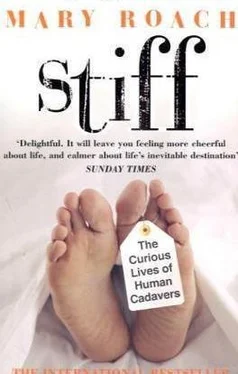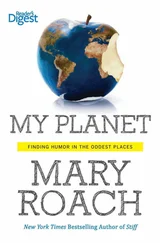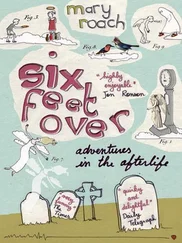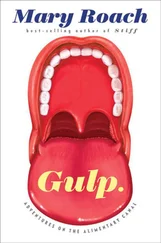Runner-up goes to a thirty-one-year-old Florida psychologist who was found collapsed in her kitchen. The Dade County medical examiner’s report itemized the fatal last meal: “8700 cc of poorly masticated, undigested hot dogs, broccoli and cereal suspended in a green liquid that contained numerous small bubbles.” The green liquid remains a mystery, as does the apparent widespread appeal of hot dogs among modern-day gorgers (from Salon.com).
This was a subject of heated debate in ophthalmology corners. Some felt that if you made baseballs softer, they would deform on impact and penetrate more deeply into the socket, causing more damage, not less. A study done by researchers at the Vision Performance and Safety Service at Tufts University School of Medicine showed that softer balls did indeed penetrate more deeply, but they didn’t cause more damage. That would have been tough to do, for the harder balls ruptured the eye “from the limbus to the optic nerve with almost total extrusion of the intraocular contents.” Let us hope that the manufacturers of amateur sports equipment have read the March 1999 Archives of Ophthalmology and adjusted the hardness of their baseballs accordingly. Either way, eye protection for Little Leaguers is a swell idea.
This was a joint effort involving the living and the dead, with the dead getting the shorter end of the stick: Following dissections of the dead penises, “10 healthy males” agreed to help confirm the findings by undergoing electrical stimulation of the dorsal nerve, as healthy males are wont to agree to.
You are perhaps wondering, as I did, whether cadavers were ever used to document the effects of accidental free falls on humans. The closest I came to a paper like this was J. C. Earley’s “Body Terminal Velocity,” dated 1964, and J. S. Cotner’s “Analysis of Air Resistance Effects on the Velocity of Falling Human Bodies,” from 1962, both, alas, unpublished. I do know that when J. C. Earley used dummies in a study, he used “Dummies” in the title, and so I suspect that a few donated corpses did indeed make the plunge for science.
Here is the secret to surviving one of these crashes: Be male. In a 1970
Civil Aeromedical Institute study of three crashes involving emergency evacuations, the most prominent factor influencing survival was gender (followed closely by proximity to exit). Adult males were by far the most likely to get out alive. Why? Presumably because they pushed everyone else out of the way.
This is no doubt why planes today are not equipped with air bags.
Believe it or not, someone actually designed an airplane air-bag system, called the Airstop Restraint System, which combined underfoot, underseat, and chest air bags. The FAA even tested the system on dummies on a DC-7 that it crashed into a hill outside of Phoenix, Arizona, in 1964. While a control dummy in a lap belt fastened low and tight about it jackknifed violently and lost its head, the Airstop-protected dummy fared just fine. The designers were inspired by stories of World War II fighter pilots who would inflate their life vests just before a crash.
I did not ask DeMaio about sheep and the purported similarity of portions of their reproductive anatomy to that of the human female, lest she be forced to draw conclusions about the similarity of my intellect and manners to that of the, I don’t know, boll weevil.
MacPherson counters that bullet wounds are rarely, at the outset, painful. Research by eighteenth-century scientist/philosopher Albrecht von Haller suggests that it depends on what the bullet hits.
Experimenting on live dogs, cats, rabbits, and other small unfortunates, Haller systematically catalogued the viscera according to whether or not they register pain. By his reckoning, the stomach, intestines, bladder, ureter, vagina, womb, and heart do, whereas the lungs, liver, spleen, and kidneys “have very little sensation, seeing I have irritated them, thrust a knife into them, and cut them to pieces without the animals’ seeming to feel any pain.” Haller admitted that the work suffered certain methodological shortcomings, most notably that, as he put it, “an animal whose thorax is opened is in such violent torture that it is hard to distinguish the effect of an additional slight irritation.”
According to the Kind & Knox Web site, other products made with cow-bone-and-pigskin-based gelatin include marshmallows, nougat-type candy bar fillings, liquorice, Gummi Bears, caramels, sports drinks, butter, ice cream, vitamin gel caps, suppositories, and that distasteful whitish peel on the outside of salamis. What I am getting at here is that if you’re going to worry about mad cow disease, you probably have more to worry about than you thought. And that if there’s any danger, which I like to think there isn’t, we’re all doomed, so relax and have another Snickers.
Is it really blood on the Shroud of Turin? According to forensic tests done by the late Alan Adler, a chemist and a Shroudie, it most certainly is. According to Joe Nickell, author of Inquest on the Shroud of Turin , it most certainly isn’t. In an article on the Web site of the famed debunking group Committee for the Scientific Investigation of Claims of the Paranormal, Nickell says forensic tests of the “blood” have shown it to be a mixture of red ocher and vermilion tempera paint.
I read on a Web site somewhere that this was the origin of the saying “Saved by the bell.” In fact, by one reckoning, not a single corpse of the million-plus sent to waiting mortuaries over a twenty-year period awakened. If the bell alerted the attendant, which it often did, it was due to the corpse’s shifting and collapsing as it decomposed. This was the origin of the saying “Driven to seek new employment by the bell,” which you don’t hear much anymore and probably never did, because I made it up.
Since the odds of our meeting at a cocktail party are slim and the odds of my managing to swing the conversation around to speculums slimmer still, let me take this opportunity to share: The earliest speculum dates from Hippocrates’ day and was a rectal model. It was to be another five hundred years before the vaginal speculum made its debut. Dr. Grigg theorizes that this was because, in the Arabian model of medicine followed at the time, women could be examined only by women, and there were very few women doctors to do the examining. This implies that most women in Hippocrates’ day never went to the gyno. Given that the Hippocratic gynecological cabinet included cow-dung pessaries and fumigation materials “of heavy and foul smell”—not to mention rectal speculums—they were probably better off.
We are fortunate that this is so, for we would otherwise have been faced with Celine Dion singing “My Liver Belongs to You” and movie houses playing The Liver Is a Lonely Hunter . Every Spanish love song that contains the word corazon , which is all of them, would contain the somewhat less lilting higado , and bumper stickers would proclaim, “I [liver symbol] my Pekingese.”
I’d never heard of him, either.
No matter, for Whytt could have kept his appointment book full with no other patient besides himself. According to R. K. French’s biography of Whytt in the Wellcome Institute of the History of Medicine series, edited by F. N. L. Poynter, M.D., the physician suffered from gout, spastic bowels, “frequent flatulence,” a “disordered stomach,” “wind in the stomach,” nightmares, giddiness, faintness, depression, diabetes, purple discolorations of the thighs and lower legs, coughing fits “producing a thick phlegm,” and, according to two of Whytt’s colleagues, hypochondria. When he died, at the age of fifty-two, he was found to have “some five pounds of fluid, mixed with a substance of gelatinous consistency and bluish color,” in his chest, a “red spot the size of a shilling on the mucous membrane of the stomach,” and concretions in the pancreas. (This is what happens when you put M.D.’s in charge of biographies.)
Читать дальше












